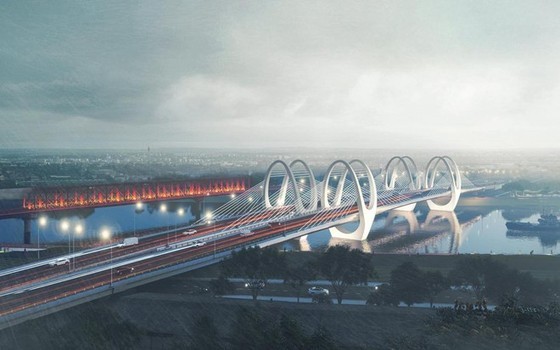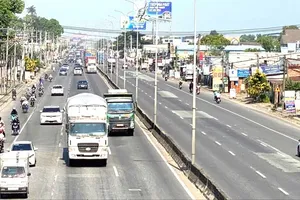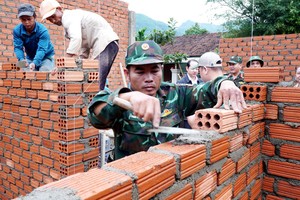 |
The perspective of the new railway bridge over the Duong River |
The project features the construction of a new Duong railway bridge and a road bridge. These new bridges will replace the existing Duong Bridge.
Among the project components, the railway bridge and the approach road have a length of 1,000 meters and are positioned approximately 16.5 meters upstream from the old Duong Bridge. Notably, this location coincides with the planned route for Hanoi's urban railway line No.1 Yen Vien - Ngoc Hoi.
The railway bridge will be constructed with six spans of steel beams and steel trusses, accommodating single-gauge railways of 1,000mm and 1,435mm, and designed for a maximum speed of 80km/h. The navigational clearance for the initial stage is 7m, and for the completion stage, it will be 9.5m. The vertical clearance for the road under the bridge is guaranteed to be at least 4.75m. Additionally, the bridge includes a pedestrian crossing on the right side of the route.
The road bridge and its approach road extend over a total length of 700 meters, located approximately 100 meters downstream from the old Duong Bridge. The road bridge will stretch across 382 meters and be constructed using durable materials such as reinforced concrete and prestressed concrete, incorporating a cable-stayed system.
The project for upgrading the Duong River waterway transport route has a total investment of nearly VND1.85 trillion. Out of this, VND650.82 billion has been allocated for land clearance phase 1, funded by the State budget. The Railway Project Management Board under the Ministry of Transport will oversee the project as the investor. The completion of the project is anticipated by 2025.
According to Deputy Minister Nguyen Danh Huy of the Ministry of Transport, the old Duong Bridge, accommodating both railway and road traffic, presents risks of traffic accidents and frequent congestion. As a result, the Government has dedicated resources to construct the new Duong railway bridge. This project holds significant importance for the national transportation system, as it progressively enhances the waterway transport capacity along waterway corridor No.1, ensuring seamless and safe passage for both waterway and railway vehicles. The Ministry of Transport will actively urge the project's management and construction units to ensure timely implementation.
Once the new Duong railway bridge is completed, the existing Duong Bridge will be dismantled. Constructed in 1902 to serve both road and railway transportation for the Hanoi - Dong Dang route, the current bridge suffers from limited vertical clearance, with only 2.8 meters during high water levels and a navigational clearance of approximately 26 meters in the center span. This bottleneck leads to extended transportation time and higher costs for waterway transport from Northern provinces to the seaports of Hai Phong and Quang Ninh.
























